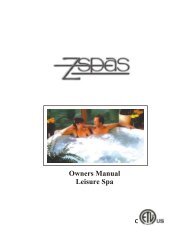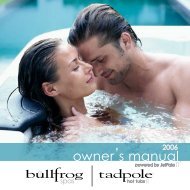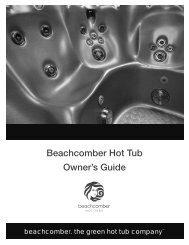Tiger Spas
2003 - All Seasons Spa
2003 - All Seasons Spa
You also want an ePaper? Increase the reach of your titles
YUMPU automatically turns print PDFs into web optimized ePapers that Google loves.
To Administer Spa Water Chemicals:<br />
1. Fold back the cover. Carefully remove and set aside the filter compartment cover.<br />
2. Push the JETS button to turn on the jet pump.<br />
3. Carefully measure the recommended amount of chemical and slowly pour it into the filter compartment. Use care not to splash chemicals on<br />
your hands, in your eyes, on the spa shell surface, or on the cabinet.<br />
4. After ten minutes, turn the jet pump off, and close and secure the cover to complete the procedure.<br />
Risk of Drowning: Never leave an open spa unattended!<br />
IMPORTANT “SUPER CHLORINATION/NON-CHLORINE SHOCK TREATMENT” NOTE: After administering a super chlorination treatment or<br />
non-chlorine shock to your spa, leave the cover open for a minimum of 20 minutes to allow the oxidizer gas to vent. A high concentration of trapped<br />
oxidizer gas which may exist as a result of the shock treatment (not daily sanitation) may eventually cause discoloration or vinyl degradation to the<br />
bottom of the cover. This type of damage is considered chemical abuse and is not covered under the terms of the limited warranty.<br />
WARNING: High sanitizer levels can cause discomfort to the user’s eyes, lungs, and skin. Always allow the sanitizer level to fall to the<br />
recommended range before using the spa.<br />
THE TIGER RIVER ® SPA WATER MAINTENANCE<br />
PROGRAM<br />
Each step in your water maintenance program is dependent on the completion of the previous steps. Omitting a step, or failing to reach the<br />
recommended range may cause an imbalance in your water chemistry. Unbalanced water chemistry can damage the spa, and its components, as<br />
well as cause discomfort for the user.<br />
FILLING THE SPA WITH WATER<br />
A. Watkins Manufacturing Corporation recommends using the FreshStart ® 10,000 pre-filter when filling the spa (through the filter compartment)<br />
with water.<br />
WARNING: DO NOT use the FreshStart 10,000 pre-filter if you plan to use granular bromine or BaquaSpa as your sanitizer.<br />
B. The FreshStart ® 10,000 pre-filter is designed to remove unwanted contaminants such as rust, dirt, detergents, and algae from the fill water.<br />
Dissolved minerals and metals such as lead, calcium, copper, and iron are not removed.<br />
C. Instructions are included with the FreshStart 10,000 pre-filter. When the spa is filled, proceed to the next step.<br />
BALANCING THE TOTAL ALKALINITY (TA)<br />
A. The recommended Total Alkalinity (TA) for your spa water is 125-150 ppm.<br />
B. Total Alkalinity is a measure of the total levels of carbonates, bicarbonates, hydroxides, and other alkaline substances in the water. TA is<br />
referred to as the water’s “pH buffer”. In other words, it’s a measure of the ability of the water to resist changes in pH level.<br />
C. If the TA is too low, the pH level will fluctuate widely from high to low. Fluctuations in pH can cause corrosion or scaling of the spa<br />
components. Low TA can be corrected by adding Hot Spring FreshWater TM pH/Alkalinity Up, or sodium hydrogen carbonate.<br />
D. If the Total Alkalinity is too high, the pH level will tend to be high and may be difficult to bring down. It can be lowered by adding Hot Spring<br />
FreshWater pH/Alkalinity Down, or sodium bisulfate.<br />
E. Once the TA is balanced, it normally remains stable, although the addition of more water with a high or low alkalinity will raise or lower the TA<br />
reading of the water.<br />
F. When the Total Alkalinity is within the recommended range, proceed to the next step.<br />
BALANCING THE CALCIUM HARDNESS (CH)<br />
A. The recommended Calcium Hardness (CH) level for your spa is 150-200 ppm.<br />
B. Calcium Hardness is a measure of the total amount of dissolved calcium in the water. Calcium helps control the corrosive nature of the spa’s<br />
water. That’s why calcium-low water (commonly known as “soft” water) is not recommended. It is very corrosive to the equipment, and can<br />
cause staining of the spa shell.<br />
C. If the CH is too high (commonly known as “hard” water), formation of scale on the spa’s shell surface and equipment can result. CH can be<br />
decreased by dilution – a mixture of 75% hard and 25% soft water will be a good starting point. If soft water is not available, or practical<br />
for you, a stain and scale control such as Hot Spring FreshWater TM Stain and Scale Defense should be added to the spa water, according to<br />
instructions on its label.<br />
D. Once the CH is balanced, it normally remains stable, although the addition of more water with a high or low calcium content will raise or lower<br />
the CH reading of the water.<br />
E. When the Calcium Hardness is within the recommended range, proceed to the next step.<br />
Page 36<br />
Water Quality and Maintenance
















